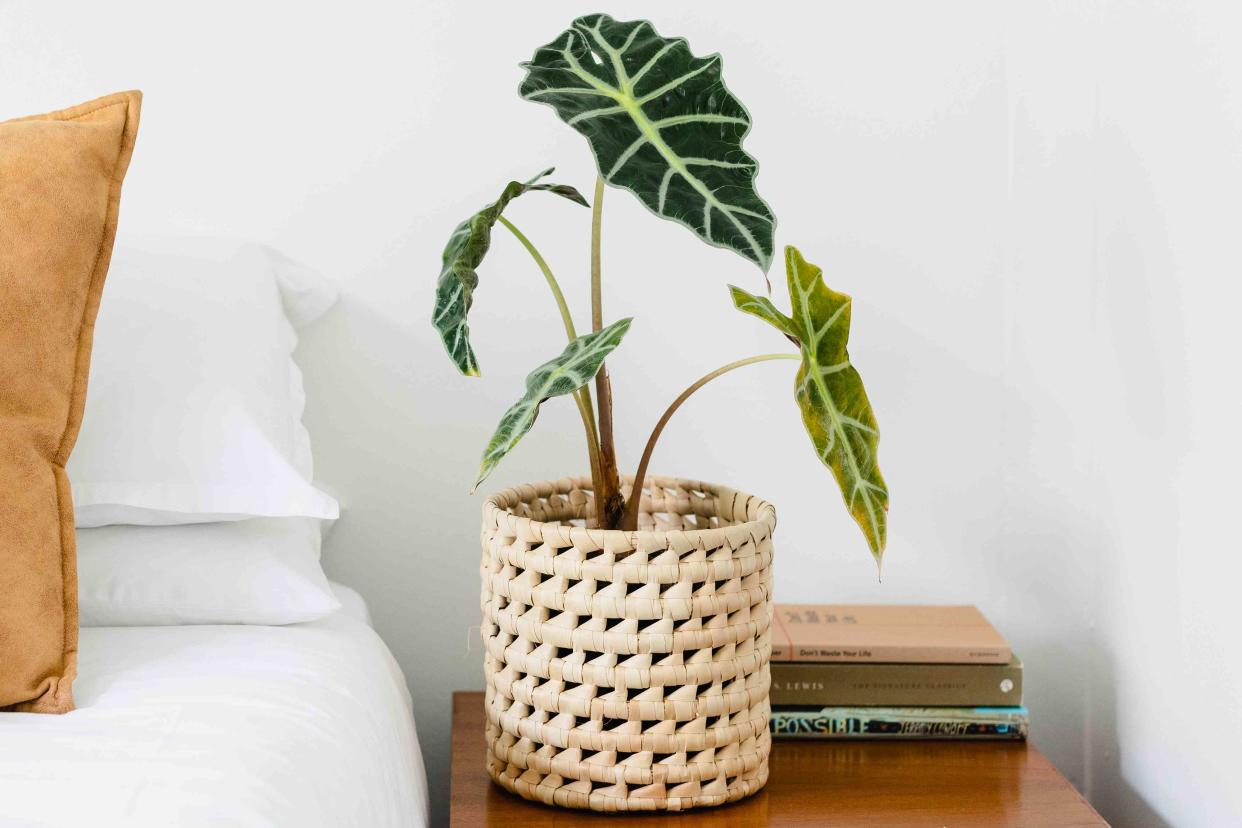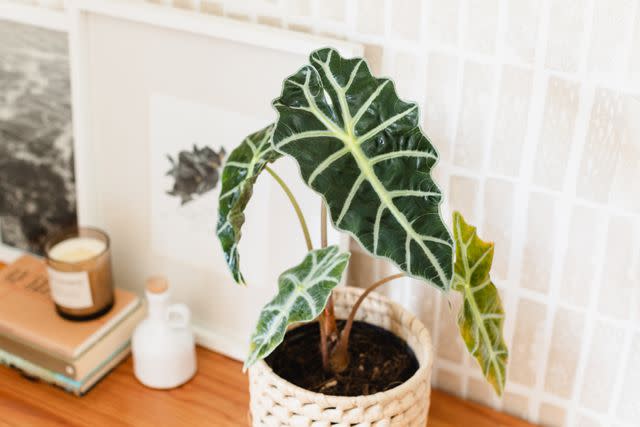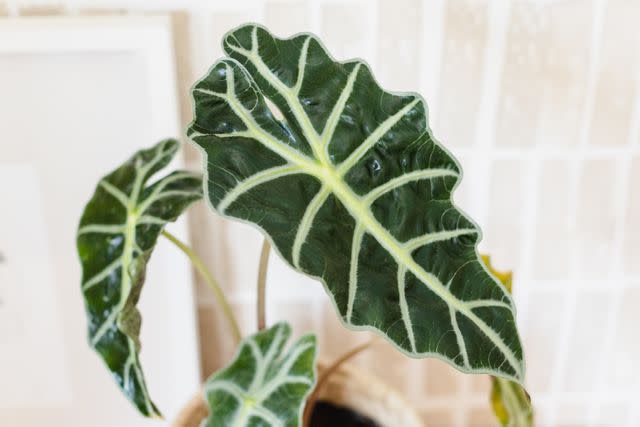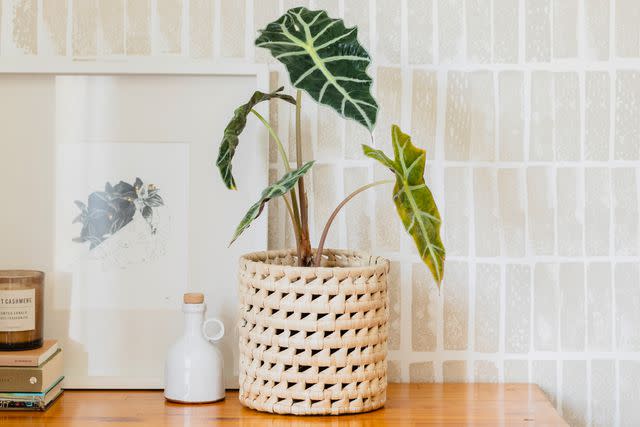How to Grow & Care for Alocasia Polly

The Spruce / Michelle Becker
Reviewed by Kathleen Miller
Alocasia Polly is an attractive houseplant that's native to tropical regions of South Asia. Alocasia Polly can be cultivated and kept indoors year-round. With the right conditions and basic care, alocasia Polly is a pretty low-maintenance, easy-growing plant. It does best in filtered, dappled sunlight. Alocasia Polly and other elephant ear plants are considered invasive in mild, wetland climates such as the Gulf Coast of the United States. Before planting alocasia Polly outdoors, consult your local extension agent to check if this plant is an invasive species in your region—or simply keep it indoors as a houseplant. Because it's mildly toxic, alocasia Polly should be kept out of reach of children and pets. Read on for our care guide.
Common Name: | Alocasia Polly, African mask plant |
Botanical Name: | Alocasia × amazonica 'Polly' |
Family: | Araceae |
Plant Type: | Bulb |
Mature Size: | 1-2 ft. tall and wide |
Sun Exposure: | Part shade |
Soil Type: | Moist, rich, well-drained |
Soil pH: | Acidic |
Bloom Time: | Summer |
Flower Color: | Pale green, cream |
Native Area: | Southern Asia |
Toxicity: | Toxic to people and pets |
Alocasia Polly Care
Here are the main care requirements for growing alocasia Polly:
Grows best with lots of filtered or dappled light
Needs moist soil
Likes high humidity and warm temperatures

The Spruce / Michelle Becker

The Spruce / Michelle Becker

The Spruce / Michelle Becker
Light
Alocasia Polly grows best with bright, indirect light, such as from an east-facing window out of direct sun. In brighter spaces, sheer curtains can help filter harsh sunlight and protect the plant's leaves from sunburn. Too much light can also cause leaves to look washed out and pale.
Soil
Plant your alocasia Polly in a rich, well-drained potting soil that contains organic matter to help retain moisture.
Water
Water your alocasia Polly so that the soil stays consistently moist. This can be a delicate balance, as soggy soil can lead to root rot, but dry soil can trigger dormancy in the plant. Avoid getting the leaves wet while watering to minimize the risk of plant disease. In winter, when the plant is not actively growing, water just when the top of the soil is beginning to dry out.
Temperature and Humidity
Alocasia Polly needs temperatures above 65 degrees or so to thrive. Lower temperatures can damage or kill the plant, so keep it out of cold spaces and drafty areas. A warm space with high humidity provides an ideal climate, making this a great bathroom plant. You can also group alocasia Polly in the same space with other humidity-loving tropicals and run a humidifier to add moisture to the air.
Fertilizer
Fertilize your alocasia Polly regularly during the growing season. Begin feeding the plant with organic houseplant fertilizer diluted to half strength every two weeks in spring, then stop fertilizing at the end of summer. Start this routine back up when spring comes around again.
Pruning
Since alocasia Polly is pretty slow-growing, especially when kept indoors, pruning is typically not needed to shape the plant or control its growth. Cut back dead or damaged leaves in spring or summer when the plant has the energy to put out new growth. Use sterilized pruners or shears and cut back leaves at the base of the stem. While alocasia Polly rarely blooms while kept indoors, it's a good idea to prune back any spent flower heads to help promote leaf growth.
Propagating Alocasia Polly
If your healthy alocasia Polly is growing from at least two bulbs with two leaves, you can propagate the plant by division. If you have a mature plant that's beginning to crowd its pot, division is a great solution. The best time to propagate alocasia Polly is during the spring and summer when the plant is actively growing. Here's how to propagate alocasia Polly by division:
Carefully remove your alocasia Polly from its pot. Using your fingers, gently remove the soil from around the root ball. You may find corms—small, dormant bulblets—in the soil. You can plant them in fresh soil along with the rest of the plant, where they'll eventually sprout, or try this water-based method of getting the corms to grow more quickly.
Separate the clumps of rhizomes with your fingers. Avoid cutting or breaking the rhizome.
Replant each clump in a new, appropriately sized pot with fresh soil and give it a deep watering. Keep the soil evenly moist and put the divisions in a warm place with bright, indirect light.
Potting and Repotting Alocasia Polly
Alocasia Polly should be repotted every two to three years to refresh its soil. If you see roots growing out of the drainage hole in the bottom of the pot, or if water doesn't seem to infiltrate the soil and runs down the sides of the pot instead of being absorbed, the plant is rootbound and will benefit from repotting.
Plan to repot in the spring when the plant is out of dormancy into a container one size larger than the previous pot. Use fresh soil and plant in a plastic or glazed ceramic pot rather than terra cotta to help maintain soil moisture.
Overwintering
During winter, your indoor alocasia Polly may stop growing or even look a little dull and droopy. That's normal for the season, with its cold temperatures and short days. However, if your plant is exposed to very cold temperatures, less light, and dry soil all at once, it may drop all of its leaves and go dormant. Don't worry—your plant isn't dead. Simply cut back on watering and wait for spring, when leaves should regrow. You can avoid dormancy in winter by using a grow light and keeping your alocasia Polly in a space that's at least 70 degrees.
Common Pests & Plant Diseases
Alocasia Polly is susceptible to common houseplant pests like spider mites, scale, mealybugs, and aphids. Keep an eye on your plant and check its foliage regularly to catch a potential infestation early. If you do spot a pest problem, remove the offenders with rubbing alcohol or neem oil and quarantine the affected plant from the rest of your collection.
How to Get Alocasia Polly to Bloom
Bloom Months
Alocasia Polly blooms in the summer months.
What Do Alocasia Polly's Flowers Look Like?
These plants grow small, pale flowers that are white or yellow.
How to Encoure More Bloom
Alocasia Polly will bloom under the right conditions. Ensure plenty of bright, indirect light and consistent moisture. Remove dead flowers to encourage more bloom.
Common Problems With Alocasia Polly
Alocasia Polly is pretty easy to care for in the right conditions, but even the most green-thumbed growers occasionally run into issues. Here are some common challenges you might come across with this houseplant.
Brown Patches on Leaves
Harsh, direct sunlight can scorch your alocasia Polly's leaves, creating brown spots. Move the plant to a location out of direct sunlight.
Leaves Turning Yellow
Overwatering or underwatering can cause yellow leaves. Check the soil moisture and adjust accordingly.
Drooping or Losing Leaves
This can be a sign of your alocasia Polly responding to seasonal changes in light and temperature during winter and either slowing growth or going into dormancy. Keep the plant warm and the soil moist, and consider using a grow light to extend hours of light per day.
Frequently Asked Questions
Can alocasia Polly grow indoors?
Yes, alocasia Polly can be grown as a houseplant with the proper conditions.
Where should I place alocasia Polly in my house?
Place your alocasia Polly in a spot with bright, indirect light, such as an east-facing window.
What’s the difference between alocasia Polly and elephant's ear?
Elephant's ear is the common name for plants in the genera Alocasia, Colocasia, and Xanthosoma, all tropical plants with heart-shaped leaves that grow from a tuber or rhizome. Alocasia Polly is a smaller relative of large elephant's ear plants.
Read the original article on The Spruce.

